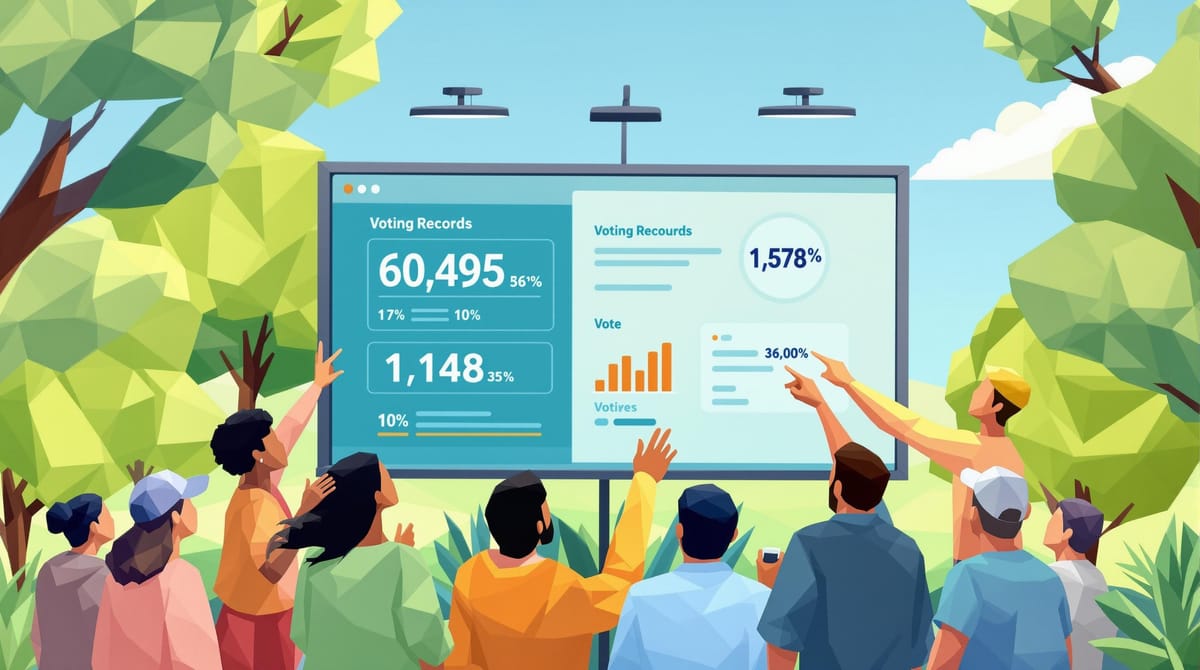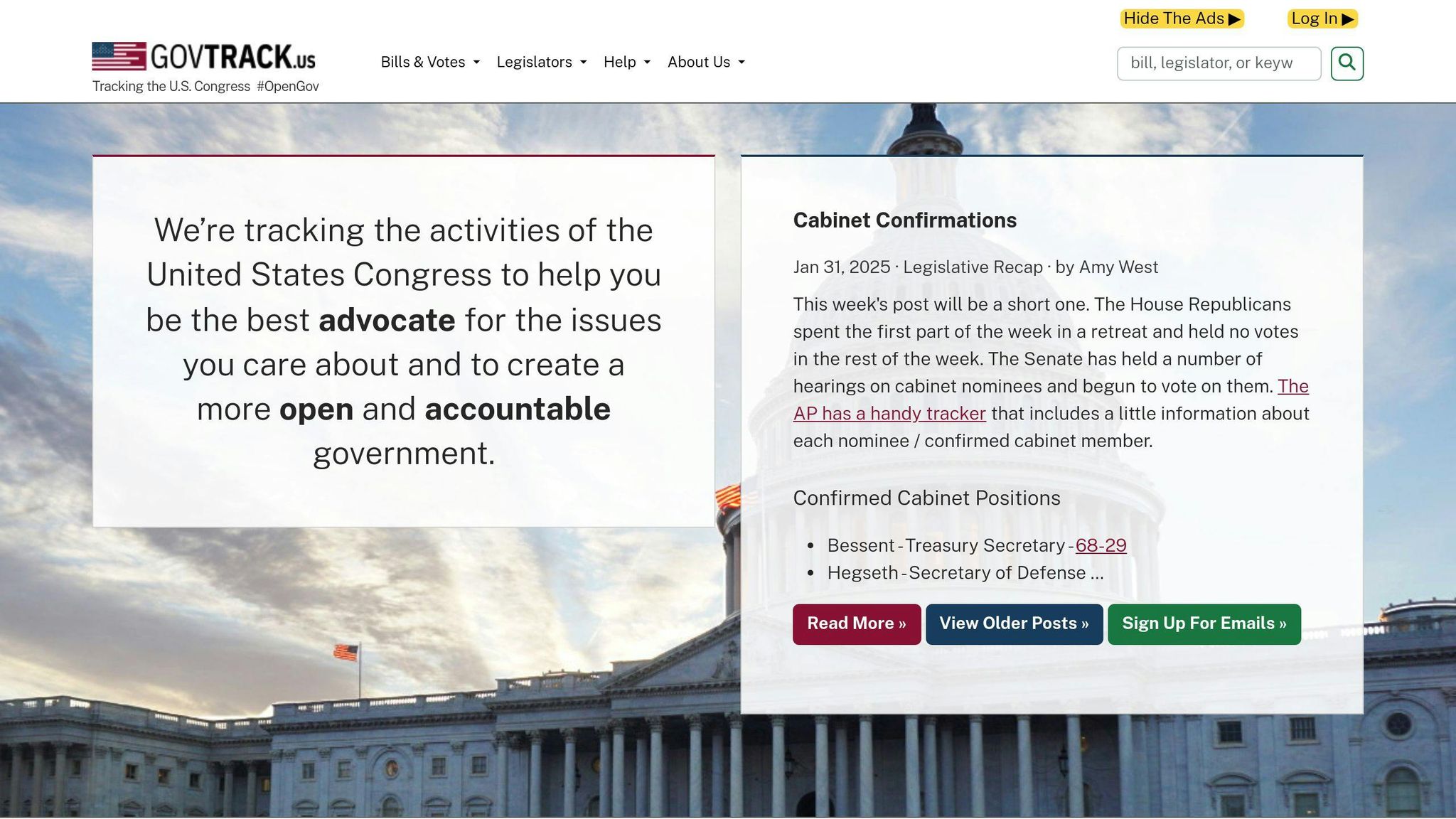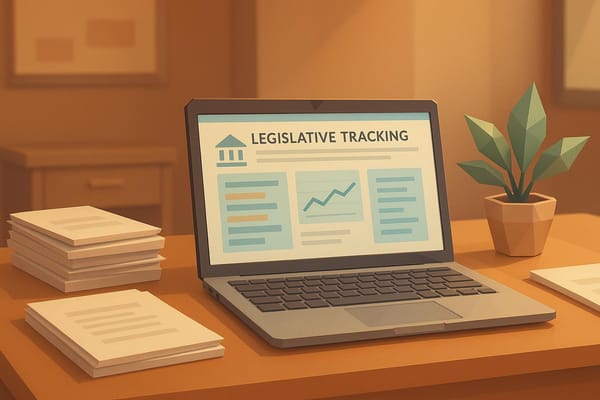5 Simple Ways to Track Your Representative's Voting Record
Learn how to easily track your representative's voting record using online tools, social media, and local events for informed civic engagement.

Want to know how your representative votes in Congress? Here’s how you can track their voting record easily.
- Congress.gov: The official platform for accurate, up-to-date voting records. Offers email alerts and detailed vote breakdowns.
- Cicada.guide: An AI-powered tool that simplifies voting data, provides summaries, and shows how votes align with your values.
- GovTrack.us: Tracks voting trends, attendance, and bipartisan efforts with visual tools and performance metrics.
- Social Media & News: Use Twitter lists, Google Alerts, and news apps for real-time updates and context.
- Local Events: Attend town halls or meetings to directly ask about voting decisions and discuss issues.
Quick Tip: Start with Congress.gov for official data, then use tools like Cicada.guide or GovTrack.us for deeper insights. Combine digital tracking with in-person engagement for a complete picture of your representative’s actions.
How To See How Representatives Voted?
1. Congress.gov: The Official Source
Congress.gov, managed by the Library of Congress, is your go-to resource for accurate and up-to-date information on your representative's voting history. As the official platform, it guarantees reliable details and serves as a solid starting point for tracking legislative activity.
The site is known for its quick updates: Senate roll call votes are available within an hour, and House roll call votes are posted immediately after voting concludes. This ensures you’re always in the loop about recent decisions.
To explore voting details, head to the Actions tab on any bill page. Here, you’ll find comprehensive information, including:
- Roll call votes
- Voice votes
- Division or standing votes
These records date back to the 101st Congress (1989-90).
Want to stay updated without constantly checking the site? By signing up for a free account, you can set up email alerts, save searches, and get weekly updates on legislative activities. The homepage also features a Current Legislative Activities section, giving you a quick overview of recent congressional actions.
For those who like to dig deeper, Congress.gov allows you to download voting data for long-term analysis. This is especially handy if you’re tracking voting patterns or comparing multiple representatives over time.
While Congress.gov is the official source, other tools offer additional features to simplify the tracking process.
2. Cicada.guide: AI-Powered Vote Tracking

Cicada.guide makes keeping up with legislation easier by using AI to turn raw data into clear, actionable insights. It’s designed to help you track and understand your representative's actions without the usual complexity.
Here’s what stands out:
- AI-generated summaries break down complicated legislation into digestible pieces.
- Personalized feeds tailor updates to your interests.
- Alignment scores show how closely your representative's votes match your values.
- State-level updates keep you informed about local legislation.
A standout feature is its question-and-answer tool. You can ask about specific bills and receive clear, AI-generated responses based on official data.
The platform organizes information into three main sections:
- 'For You': Customized updates based on your preferences.
- 'Tracking': Focused on specific legislation you’re following.
- 'Discover': A space to explore new bills and topics.
Cicada.guide pulls data from various sources, using AI to simplify legislative details and highlight voting trends. For the most accurate understanding, it’s a good idea to cross-check its insights with official government platforms.
While Cicada.guide offers advanced AI tools, platforms like GovTrack.us also provide reliable resources for analyzing voting records and legislative actions.
3. GovTrack.us: Data-Driven Vote Analysis

GovTrack.us, established in 2004, combines official records from Congress.gov with its own tools to help you analyze your representative's voting patterns. This independent platform offers dashboards, tracking features, and metrics to give you a clear picture of their performance.
The Vote Analysis Dashboard provides detailed insights into attendance, party-line voting, and productivity. It tracks patterns all the way back to the 93rd Congress (1973-1974). You can monitor bills your representative sponsors, committee activities, floor votes, and amendments, all while setting up custom alerts to stay updated.
Here are some of the key performance metrics GovTrack.us uses:
| Metric Type | What It Measures | Why It Matters |
|---|---|---|
| Attendance Score | Percentage of votes attended | Reflects how actively they participate |
| Legislative Impact | Bills sponsored/passed | Shows their ability to get things done |
| Bipartisan Index | Cross-party cooperation | Highlights their willingness to collaborate |
GovTrack.us also offers email notifications, allowing you to set alerts for specific bills, representatives, or topics. To make things easier, the platform includes tools that break down complex legislative terms and procedures, helping you better understand voting records.
What sets GovTrack.us apart is its focus on historical trends and comparisons. The platform's visualization tools let you compare your representative's voting patterns with others in Congress. This can help you spot trends and see where their votes align - or clash - with party positions.
While GovTrack.us is a great resource for detailed analysis, you might also want to follow social media and news outlets for broader updates.
4. Social Media and News Updates
Social media and news platforms are great for staying updated on your representative's voting record and public statements in real time. One way to streamline this is by creating a Twitter list that includes your representative's official account, their office, relevant committees, and local journalists.
Here are a few key tools to set up for tracking updates:
| Tool | Purpose | Setup Tips |
|---|---|---|
| Google Alerts | Get daily email updates | Track key votes and public statements |
| Twitter Lists | Follow real-time updates | Include local journalists and policy experts |
| News Apps | Stay on top of breaking news | Turn on push notifications for key votes |
Major outlets like The New York Times and Politico offer specialized congressional coverage, often with mobile app alerts tailored to specific representatives or bills. On the other hand, local news sources can give you more detailed information about district-specific voting trends and events like constituent meetings.
It's also important to verify claims. Double-check social media statements against official records on Congress.gov, as announced positions don't always align with actual votes.
For a well-rounded approach, combine national outlets for broader legislative updates, local newspapers for district-specific news, and political newsletters for deeper congressional insights. Dedicate about 15 minutes each day to reviewing your curated news feeds and social media lists to stay informed.
While these tools provide instant updates, attending local events can give you a more personal understanding of your representative's actions.
5. Local Meetings and Events
Digital tools are great, but nothing beats face-to-face interactions when it comes to holding your representative accountable. Town halls and community meetings give you a chance to directly ask questions and discuss voting records. In fact, 97% of congressional staff say in-person visits from constituents strongly influence undecided representatives.
To find these events, start by checking your representative's official website, social media pages, or the Town Hall Project database. These meetings often happen during congressional recesses, which you can track on congress.gov. Common formats include traditional town halls, community update sessions, and even telephone town halls, each offering a way to connect.
"If meeting with a U.S. senator or representative, it is better to hold meetings in the district when he or she is back from Washington." - American Postal Workers Union
Preparation is key to making the most of these events. Before attending, look up recent votes on Congress.gov and craft specific questions about bills that matter to your district. For example, instead of asking general questions, you might say, “Can you explain your recent vote on H.R. [number] and its impact on our district?” When speaking, introduce yourself as a constituent, share a personal story related to the issue, and take notes during the discussion. After the meeting, send a thank-you email to strengthen the connection.
If your representative rarely hosts town halls, team up with other constituents to request more frequent meetings. Many officials also hold informal events, which can be great opportunities to discuss voting records and legislative goals in a more casual setting.
Conclusion
Keeping track of voting records has never been easier, thanks to digital tools and in-person opportunities. By using resources like Congress.gov, GovTrack.us, and Cicada.guide, you can get a clear picture of your representative's legislative actions.
Combining Congress.gov's official records with platforms like GovTrack.us and Cicada.guide offers both accuracy and context. GovTrack.us highlights voting trends and patterns, while Cicada.guide simplifies complex legislation with AI-powered summaries.
"Staying informed about a representative's voting record can empower individuals to make informed decisions at the polls, engage in meaningful discussions about policy issues, and hold elected officials accountable for their actions, thereby strengthening democratic processes."
| Method | Key Benefit |
|---|---|
| Congress.gov | Reliable, official vote records |
| Cicada.guide | AI summaries and alignment insights |
| GovTrack.us | Trends and performance metrics |
| Social Media | Real-time updates |
| Local Events | Face-to-face engagement opportunities |
Staying informed requires active participation. Using these tools ensures you're equipped to engage in democracy and hold representatives accountable. Whether it's specific bills, voting trends, or direct engagement, these resources provide everything you need to stay informed and involved in the democratic process.




